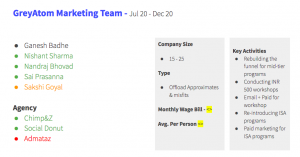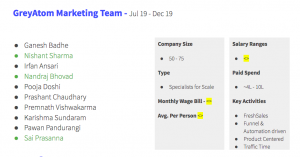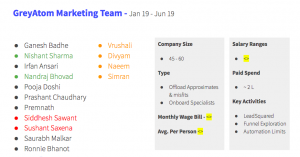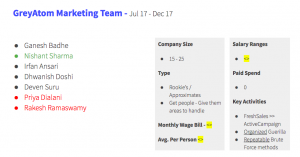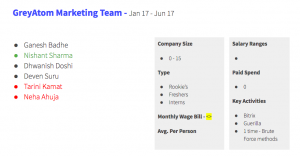Growth function typically comprises of Sales, Marketing and Product functions. I have been at the helm of affairs running a Marketing team for good amount of time in my life. Some reflections from the same.
Plenty has been written on this topic. My attempt is NOT to regurgitate. But to present a perspective from inside a Growth role. The challenges, the successes, and the failures. This is NOT a like of hacks or advisory on scaling growth teams. But please treat this as a lens through which you need to look at your venture and chart your Growth team ahead.
- Words:1735 (Skim friendly)
- Type: Post
- Video:0
- Slides: 0
- Topic: Humans Of EdTech
- TIME: 6 Minute
I’m going to reflect on the Growth Team’s at GreyAtom.
I reflected on the structure of the growth team for the last four years in the intervals of six months each.
Interns & Rookies
When we started out, we were a totally rookie team, a completely a team full of rookies, freshers interns. The company size at that point in time was less than 10, to be very honest. And in the first six months, we built a team of total interns. So the only people who were there were all interns.
The reason for doing this is, we were not sure of our messaging; we were not sure of the product that was evolving. In really early days, all you required was a lot of experimentation, and you wanted people who are essentially can take your orders, and try out some of these things. We were invested in Bitrix24 as a CRM at that point in time.
A lot of our stuff was very crude. One time brute force methods, nothing repeatable. And we didn’t think of longevity at that point in time, we just wanted to get a lot of these things done. We essentially kept on building the team. The hypothesis of target audience was working professionals two to five years. Scouting for email addresses; sending them Quora campaigns; LinkedIn outreach one-on-one basis. So that was the first good three, four months.
Approximates
Then the marketing team essentially started growing where we started hiring approximates. We got people and then we give them areas to handle and let them grow with it. So the significant addition in this timeframe was a video editor because we wanted them to edit the videos and send it back to the students. Someone who was a generalist in Content and Generalist in Community. We had moved from Bitrix24 to FreshSales. We got into a slightly more organised guerrilla version. Repeatable brute force methods. So those methods were still brute force, but they were repeatable. That’s exactly how we used to work at that point in time. Build a steady ToFu, Building data science blog posts, topic tree, building content on different topics and repurpose endless content on Quora, blogs, multi touch sales process, Level One – Level Two tele callers.
Experimenting with better CRMs, with new sales process that was typically the team for the next six months. We started getting in slightly deeper version of specialist. So people who are specifically on content, on video content side, social media side, people who had some sort of background in marketing, all those kinds of people. So essentially got some of those people we moved on to lead square. And I think this was repeatable, and marginally scalable brute force methods. So I think definitely we will now get from repeatable and scalable brute force methods.
So some common themes in this time frame were looking for answers blogs, building an ecosystem of data science, mentors, deciding partners, community building, engagement of communities, so on. Then we moved on to a size of a company which was around 30. We had some first specialists, people who came in the team, a lot of interns, temp staff, we have some focus mandates, funnel consciousness, automation came in, nothing was brute force. A lot of things were automation driven. A lot of content building came into play in this part.
So, customer journeys, average customer conversion time. Building various journeys on top of the funnel, mid funnel, the bottom of the funnel referrals, payments, follow-ups, engagement of communities webinars, a lot of advertising. We started offloading all the approximates, all the Misfits, and we were just onboarding specialists. So you had a person for paid marketing, for video production, for SEO, for senior marketing manager. We hired someone who joined us on the video team. So all of those things typically came over here.
Funnel automation, deep integration of product & website, design uplift on page, SEO, auditing paid spends growing MQLs. So putting in the growth loops. Then essentially, we had people who, we bought in again on the paid marketing side, content side. So many interesting people typically joined us in this point in time. So, in order it is the, we shifted the CRM on here, to a more funnel automation driven approach more product centric. traffic was the priority. Setting a CleverTap or SmarTech, identifying email, setting events on websites, building journeys, notification.
Outsourcing the specialised efforts we bought in the digital agency, we introduced the in house marketing team, optimising the scripts, better targeting, exploring different channels, cracking the campus channel, by the liquids for ice started building the relations with training placement, officers conducting drives, all those things happen. Changing the product line, mid-tier products, the workshops, middle funnel for and most sales support, started working with an agency targeted Facebook only for introductory workshop.
And finally, we are working with three people. Where we have agencies. It’s a very lean team that we have internally, they building the funnel for mature programmes conducting the workshops, reintroduced by say those products essentially focus.
So that’s like a really high-level overview. And this is the structure that we have regarding different people, digital marketing, customer acquisition, SEO, SEM, those things.
Now, let’s quickly go on to the major topic for this blog. So we looked at the stage is team composition & team structure. Let’s come to where, you know building the cool team. Now, one of the key things that you need to have when you’re building a growth team, a marketing team is essentially to hire this team top down. And there is nothing called as bottom up hiring over here. There’s nothing called as a bit of hiring over here there is a top-down hiring that should happen in this team. So you have to bet on a single strong growth leader for your organisation. So we need to then hire a senior marketing manager.
And you need to significantly get invested in freelancers and gig workers. There are people see you cannot expect to own all the skills from all the freelancers and all the people in the house. So it is very important that you own some of these skills in freelance capacities as gig worker capacities, for different growth mandates, so you bring in people with specific skills.
So that’s what I think you need to work consistently with freelancers agencies and no gig workers to take on specific growth mandates. And then you need to have like a senior marketing manager who’s in house, hire an agency. At a point in time, once you have identified some very clear paid budgets for them, hire an agency for the social media marketing, and SEO. Absolutely on day zero. So those things need to go live on your social media presence very, quickly and very, quick.
You need to decouple the process and tooling from people when hiring people. So, what happens is whenever you hire a senior manager or a CMO or a VP marketing, what will end up happening is that they will bring with them their own tools, and they will also come with the recommendations of whom they should hire for their teams and roles, whom they should hire for their teams and roles. So, every time a senior person comes in over here, they bring in with them significant amount of disruption. And that is not always welcome. So, you really need to control that and it is not by controlling the people, but it is about just bringing in the people, but also carrying forward your processes and your tooling. And then gradually shifting and replacing only the most essential required needed items over here.
What is very important is to have a very clear well defined growth team structure and growth team is not just a marketing team, a growth team is also a team which is growth team, engineering team, marketing team, sales team, all of them need to operate in a very consistent uniform way with the product team? One more thing is that it cannot happen that only the growth team or the marketing team grows on the other team does not grow. It cannot happen. It is that all the team grows on the other team grows. So these are some things that typically happen.
Some common mistakes over here are that what is the role of designers or design teams within a marketing fold? Is this competency better own in house or something that is to be owned externally? But the thing over here is that you need to have at least a couple of people in your organisation who are handling the whole of the design.
By Design, we mean the user experience product design, website design, communication, video language across all the visual mediums one person has to own this and we cannot distribute this skill, the scale cannot be having different other ways. Essentially, the role of designer in the marketing team can be very limited. And you might find capacity fluctuating or occupancy fluctuating for this person from time to time basis. Good people in the design team come at a particular premium. And hence it is very clear that you have a significant consistent roadmap for them.
The next is the SEO strategy. In the company strategy. The company can have different models, products, businesses at different points in time in its life. But the SEO strategy essentially needs to be common, it needs to be robust and same. Great.
So regarding bootstrapping, growth team bootstrapping a marketing team, there is no set single recipe, but essentially many best practices that we can adopt. Essentially, it comes down to again, getting the people-process tools in sync. Regarding people, it is about hiring the right people at the right point in time. Having a clear set of expectations.
Having freelance and gig workers and agencies in sync at different points in time and augmenting the capabilities. Building a core team, but always keeping on augmenting it with people who are external consultants and helping you at different stages of your growth. So that’s essentially the strategy over here.
Photo by Jose Francisco Fernandez Saura from Pexels
Join to get sneak peek into what's happening
I write about books, experiences, product, UX, EdTech, early stage growth, validation – mostly tech. Subscribe if these topics interest you. Once every 15 days emailer. I promise – No spam. (I am known for it otherwise) 😉

